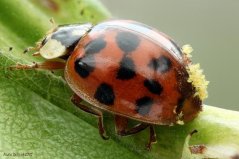
News
Natural enemies of non-indigenous Asian ladybird discovered in the Netherlands
Despite initial fears to the contrary, it appears that the exotic Multi-coloured Asian ladybird does have natural enemies in the Netherlands. Wageningen researcher Lidwien Raak-Van den Berg and colleagues recently announced this discovery. Several years after the first record of the Asian ladybird, these natural enemies appear to have made the switch from native ladybirds to the exotic species. The study, which was conducted by researchers at Wageningen UR with colleagues from Tilburg (the Netherlands) and Harvard (USA), was published in the journal BioControl.
The Multi-coloured Asian ladybird (Harmonia axydiris) is not native to Europe, but was introduced to control aphid infestations. Because the insect did not have any natural enemies initially, it was able to spread rapidly. H. axydiris poses a threat to the native ladybird, but has negative effects on fruit production and causes allergic reactions in humans.
Effect fungi and nematodes in beetle populations

In their study of the history of the Asian ladybird since its introduction in Europe and how it has managed to establish itself successfully, Lidwien Raak and her colleagues discovered a number of natural enemies. These began to emerge several years after the establishment of the ladybird. It concerned fungi, nematodes and, to a lesser extent, mites. The researchers found high levels of fungal infection in the exotic ladybird. In addition, nematodes (parasitic roundworms) were found in almost every population.
At this stage the researchers cannot specify the effect of the fungi and nematodes on the exotic ladybird populations. However, there is strong evidence that females infected with nematodes no longer lay eggs. Lidwien Raak: “Perhaps the use of nematodes is a good way to suppress the H. axydiris population to a certain extent.”